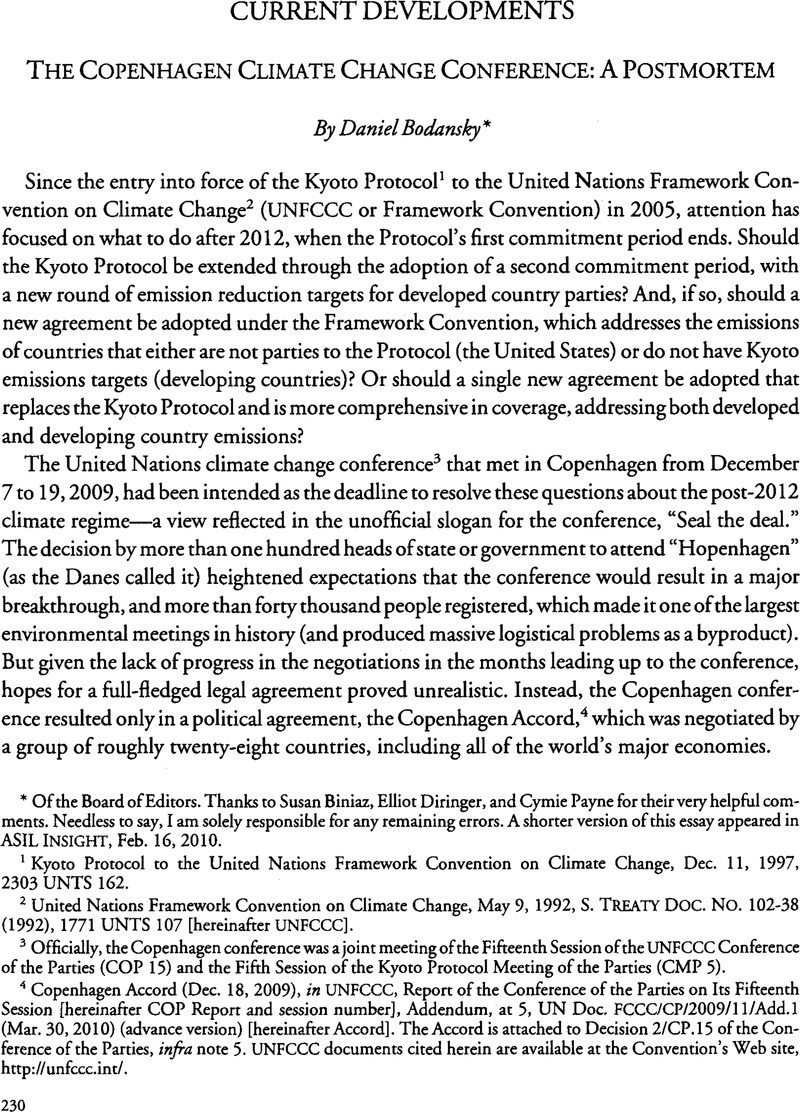Article contents
The Copenhagen Climate Change Conference: A Postmortem
Published online by Cambridge University Press: 27 February 2017
Abstract

- Type
- Current Developments
- Information
- Copyright
- Copyright © American Society of International Law 2010
References
1 Kyoto Protocol to the United Nations Framework Convention on Climate Change, Dec. 11, 1997, 2303 UNTS 162.
2 United Nations Framework Convention on Climate Change, May 9, 1992, S. Treaty Doc. NO. 102-38 (1992), 1771 UNTS 107 [hereinafter UNFCCC].
3 Officially, the Copenhagen conference was a joint meeting of the Fifteenth Session of the UNFCCC Conference of the Parties (COP 15) and the Fifth Session of the Kyoto Protocol Meeting of the Parties (CMP 5).
4 Copenhagen Accord (Dec. 18, 2009), in UNFCCC, Report of the Conference of the Parties on Its Fifteenth Session [hereinafter COP Report and session number], Addendum, at 5, UN Doc. FCCC/CP/2009/11/Add.1 (Mar. 30, 2010) (advance version) [hereinafter Accord]. The Accord is attached to Decision 2/CP. 15 of the Conference of the Parties, infra note 5. UNFCCC documents cited herein are available at the Convention’s Web site, http://unfccc.int/.
5 Decision 2/CP.15 (Dec. 18-19, 2009), in COP Report No. 15, supra note 4, at 4 (in which the Conference of the Parties “[t]akes note of the Copenhagen Accord of 18 December 2009”).
6 UNFCCC, Information Provided by Parties to the Convention Relating to the Copenhagen Accord, available at http://unfccc.int/home/items/5262.php.
7 The Marrakesh Declaration and the Marrakesh Accords, in COP Report No. 7, Addendum, UN Doc. FCCC/ CP/2001/13/Add.1 (Jan. 21, 2002).
8 The Berlin Mandate: Review of the Adequacy of Article 4, paragraph 2(a) and (b), of the Convention, Decision 1/CP.l, in COP Report No. 1, Addendum, at 4, UN Doc. FCCC/CP/1995/7/Add.l (June 6, 1995).
9 Bali Action Plan, Decision 1/CP.13 (Dec. 14-15, 2007), in COP Report No. 13, Addendum, at 3, UN Doc. FCCC/CP/2007/6/Add.l (reissued Mar. 14, 2008).
10 Advancing the Work of the Ad Hoc Working Group on Further Commitments for Annex I Parties Under the Kyoto Protocol, Decision 3/CMP.4, para. 4, in CMP Report No. 4, UN Doc. FCCC/KP/CMP/2008/11/Add.l (Mar. 19, 2009).
11 Advancing the Bali Action Plan, Decision 1/CP.14, para. 5, in COP Report No. 14, Addendum, at 2, UN Doc. FCCC/CP/2008/7/Add.l (Dec. 12, 2008).
12 UNFCCC, supra note 2, Art. 2.
13 Bali Action Plan, supra note 9, para. 1(a).
14 Accord, supra note 4, para. 2.
15 Id, para. 12.
16 Id., para. 4.
17 Id, para. 5.
18 In the case of least-developed countries and small island developing states, actions may be taken “voluntarily and on the basis of support.” Id.
19 Id.
20 Id, para. 8.
21 Id, para. 10.
22 Id., para. 9.
23 Id., para. 8.
24 Id., para. 6.
25 Id, para. 3.
26 Id, para. 4.
27 Id., para. 5.
28 See supra note 5.
29 For an up-to-date summary of national submissions related to the Copenhagen Accord, see US Climate Action Network, Who’s on Board with the Copenhagen Accord? at http://www.usclimatenetwork.org/policy/ copenhagen-accord-commitments. For the submissions, see also Information Provided by Parties to the Convention Relating to the Copenhagen Accord, supra note 6.
30 Accord, supra note 4, pmbl.
31 Indeed, Cuba has already challenged the authority of the UNFCCC Secretariat to compile submissions from states regarding their willingness to associate themselves with the Copenhagen Accord and/or their national mitigation targets or actions.
32 Outcome of die Work of the Ad Hoc Working Group on Long-Term Cooperative Action Under the Convention, Decision 1/CP.15, para. 1 (Dec. 18-19, 2009), in COP Report No. 15, supra note 4, at 3.
33 After Copenhagen, the four BASIC countries (Brazil, China, India, and South Africa) issued a joint statement in which they “underscored die centrality of the UNFCCC process and the decision of the parties to carry forward the negotiations on the two tracks” of the two ad hoc working groups. Joint Statement Issued at the Conclusion of the Second Meeting of Ministers of BASIC Group, New Delhi (Jan. 24, 2010), available at http://www.chinafaqs.org/files/chinainfo/BASIC%20Joint%20Statement%2024%20January%202010.pdf.
34 Lavanya Rajamani, for example, says that the Accord “can plausibly be characterized as ’rotten’ not just because it is weak and will not contain climate change in its current form, but also because even in this weak form it faces considerable legal and procedural challenges to its operationalization.” Lavanya Rajamani, Copenhagen Accord: Neither Fish nor Fowl 26, 26 (Feb. 2010) (Centre for Policy Research Seminar 606, paper), available at http://www.cprindia.org/. Similarly, Navroz Dubash refers to the Accord as a “paper-thin cover-up of what was a near complete failure,” and suggests that the results in Copenhagen may “represent[] the worst possible outcome—the overlay of a thin veneer of success over what is a deeply flawed outcome, perpetuating a process that is unable to overcome entrenched differences.” Navroz, K. Dubash Copenhagen: Climate of Mistrust , Econ. & Pol. Wkly., Dec. 26, 2009, at 8, 9, 10, available at id.Google Scholar
35 Kelly, Levin & Rob, Bradley Comparability of Annex I Emission Reduction Pledges (Feb. 2010) (World Resources Inst, working paper), at http://www.wri.org/publication/comparability-of-annexi-emission-reductionpledges Google Scholar; Press Release, Ecofys, Climate Action Tracker, Ambition of Only Two Developed Countries Sufficiently Stringent for 2°C (Feb. 2, 2010), available at http://www.climateaaiontracker.org/. But according to Andrew Light of the Center for American Progress, the pledges put on the table thus far could achieve as much as two-thirds of the emissions reductions needed to achieve die 2°C target. Andrew Light, Progress from the Copenhagen Accord (Feb. 9, 2010) (Center for American Progress), at http://www.americanprogress.org/issues/2010/02/copenhagen_progress.html.
36 For a similar view, see David, Doniger, The Copenhagen Accord: A Big Step Forward, Posting to Nat. Resources Defense Council blog, http://switchboard.nrdc.org/ (Dec. 21, 2009).Google Scholar
- 160
- Cited by


